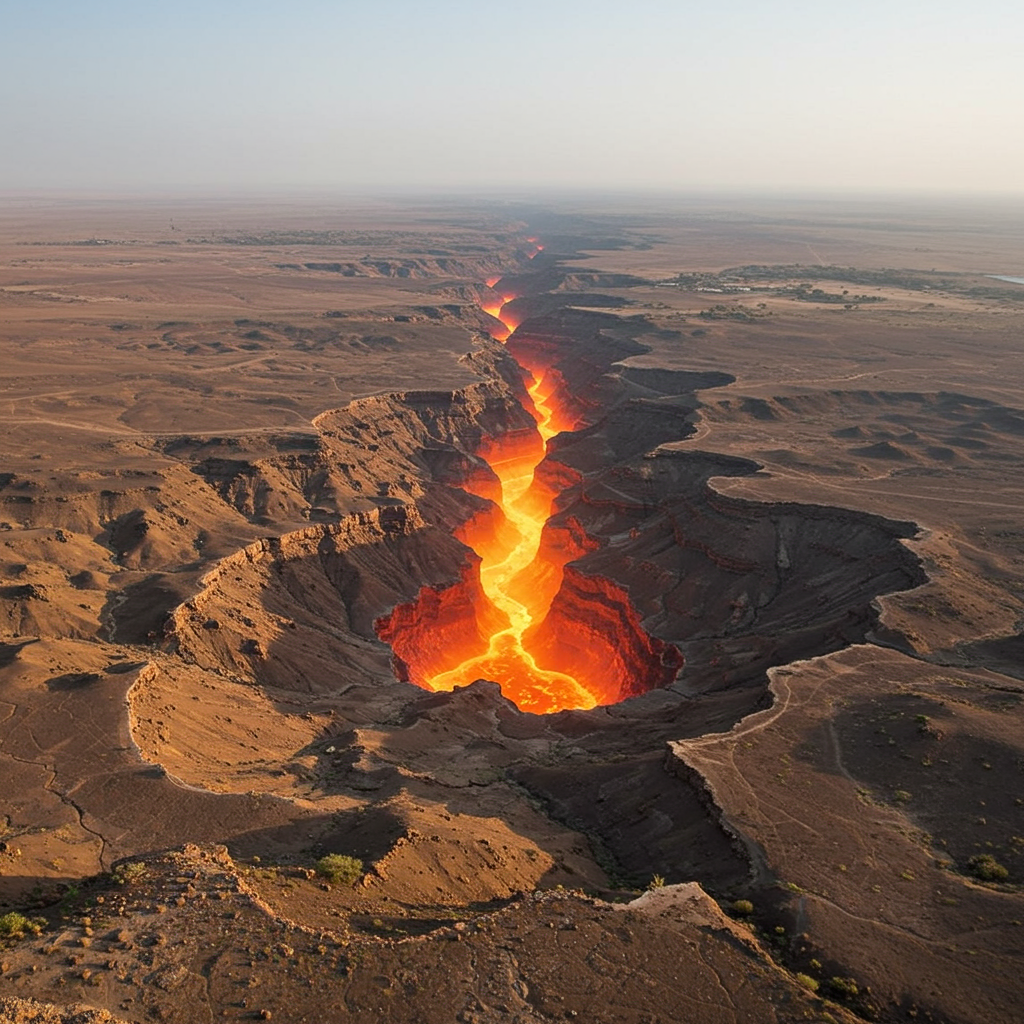Beneath the surface of eastern Africa, a monumental geological event is slowly unfolding. In Ethiopia’s remote Afar region, a vast tract of land is gradually splitting apart, laying the groundwork for the birth of a new ocean. Scientists have long suspected that intense geological activity here is driven by a powerful force deep within the Earth. Now, new research provides compelling evidence that a rhythmic, pulsing flow of superheated rock, known as a mantle plume, is the engine behind this dramatic transformation.
This remarkable finding sheds light on how continents fracture and could even explain massive volcanic events from Earth’s distant past. Understanding this subterranean “heartbeat” offers profound insights into the dynamic connection between our planet’s deep interior and its ever-changing surface.
Unveiling Earth’s Deep Heartbeat
The Afar Depression in Ethiopia is a geological marvel. It sits at the junction of three colossal tectonic plates: the Main Ethiopian Rift, the Red Sea Rift, and the Gulf of Aden Rift. Here, Earth’s crust is being stretched and pulled in multiple directions simultaneously. This creates a unique environment where processes forming brand new oceans are happening right alongside areas experiencing continental breakup. The significant volcanic activity and frequent earthquakes in this region are clear signs of immense forces at work below.
Geologists hypothesized that a hot mantle upwelling, a column of unusually hot rock rising from deep inside the Earth, fueled this activity. However, the precise structure and behavior of this suspected plume remained mysterious. To uncover its secrets, researchers embarked on an ambitious study.
A Plume That Pulses
The scientific team analyzed more than 130 samples of relatively young volcanic rocks collected from across the Afar region. Volcanic rocks act like geological time capsules, preserving chemical signatures from the molten rock, or magma, they originated from. By examining the chemical compositions of these samples, scientists could infer details about the depth and makeup of the melted rock beneath the surface.
They combined this chemical analysis with sophisticated computer models. These models simulated how the region’s geology would respond to different types of mantle plumes. By comparing these simulations with existing geological data, the team could build a clearer picture of the actual plume beneath Afar.
A crucial discovery emerged: the mantle upwelling isn’t a simple, uniform column. Instead, it is asymmetrical, resembling a complex “patchwork” of varying types of hot mantle material. More astonishingly, the researchers found that molten rock rises upward from this plume in rhythmic surges or “pulses.” They likened this behavior to a heartbeat. These pulses leave behind distinct chemical fingerprints within the volcanic rocks, observed as layers or “chemical striping.”
How Plate Motion Guides the Flow
A significant insight from the study is the intimate link between the pulsing plume and the tectonic plates grinding away above it. The characteristics and efficiency of these mantle pulses are strongly influenced by the properties of the overlying plates, specifically their thickness and how fast they are pulling apart.
Imagine the mantle flow as blood pumping through arteries. In areas where the overlying tectonic plate (the lithosphere, comprising the crust and upper mantle) is thinner and stretching faster, like the Red Sea Rift, the mantle pulses travel more efficiently and regularly. The hot material is channeled upward, almost like a strong pulse through a narrow vessel.
Conversely, where the lithosphere is thicker or the rifting is slower, the upward flow of the mantle is impeded. This resistance causes the chemical signatures from the pulses to be more condensed or tightly spaced in the resulting rocks. In areas with thinner lithosphere, the chemical striping is more spread out, indicating less resistance to the mantle’s upward surge. This dynamic coupling between deep mantle upwellings and the movement of tectonic plates above reshapes our understanding of continental breakup.
The Mechanism of Ocean Birth
This powerful mantle upwelling is actively eroding the rigid lithosphere from below. In some spots, it has thinned the Earth’s outer shell to as little as 15 kilometers. This extreme thinning, combined with the horizontal stretching force from the diverging tectonic plates, triggers periodic episodes of intense volcanic activity. Evidence of this includes widespread lava flows across Ethiopia and swarms of earthquakes, indicating the formation of new crustal material.
The ultimate consequence of these deep-Earth processes is profound: the region is destined to be flooded by seawater. This inundation will lead to the splitting of the Horn of Africa from the mainland. Geologically speaking, this mirrors the ancient process that formed the Atlantic Ocean between Europe and North America millions of years ago. The Afar region offers a rare, live view of this planet-shaping phenomenon in action.
Broader Implications and Future Insights
Understanding the “tempo” and nature of these mantle “heartbeats” has implications far beyond regional geology. It could provide critical insights into massive volcanic events from Earth’s past. Phenomena like Large Igneous Provinces (LIPs), such as the one that formed 60 million years ago in the North Atlantic, released colossal volumes of lava. These eruptions likely caused significant climate changes due to emitted gases and some might even be linked to mass extinction events. Deciphering the behavior of modern mantle plumes could help explain these ancient catastrophes.
This research highlights a direct, dynamic link between the Earth’s deep interior and its surface manifestations. Future studies in the Afar region are planned to investigate the precise rate of mantle flow beneath the different tectonic plates. Mapping how this flow directs volcanic vents is also a key area for further exploration. Scientists emphasize that fully understanding these complex subsurface processes requires multi-disciplinary collaboration across geology, chemistry, and geophysics. While other phenomena like water loss can cause land uplift, as seen in parts of South Africa, the processes in Afar are uniquely tied to the fundamental tearing apart of a continent driven by deep mantle forces.
Frequently Asked Questions
What is a mantle plume and how does it cause a new ocean?
A mantle plume is a rising column of unusually hot rock originating from deep within Earth. When it reaches the shallower mantle beneath tectonic plates, the reduced pressure causes the hot rock to partially melt, forming magma. This magma rises and pushes on the overlying crust. In areas where tectonic plates are already pulling apart (rifts), the plume provides extra heat and force, accelerating the thinning and fracturing of the crust. Over millions of years, this process creates a deep valley, which eventually widens enough to be flooded by seawater, forming a new ocean basin.
Why is the mantle plume beneath Ethiopia called a “heartbeat plume”?
Scientists used the analogy of a “heartbeat” to describe the rhythmic way that molten rock rises upward from the plume beneath Ethiopia’s Afar region. New research analyzing the chemical composition of volcanic rocks revealed distinct patterns, referred to as “chemical striping.” These stripes are evidence that the magma wasn’t rising continuously but in discrete surges or pulses, much like the beats of a heart, leaving unique chemical signatures in the rock record.
What are the future predictions for the Afar region based on this geological activity?
Based on the ongoing continental rifting driven by the mantle plume and tectonic plate movement, the Afar region is predicted to continue stretching and sinking. Ultimately, over millions of years, this process will cause the land to drop below sea level and be inundated by water from the Red Sea and Gulf of Aden. This will lead to the geological separation of the Horn of Africa from the rest of the continent, creating a new ocean basin in the rift valley.
In conclusion, the discovery of the pulsing mantle plume beneath Ethiopia offers a captivating glimpse into the immense, slow-moving forces shaping our planet. This research not only clarifies the drivers behind the formation of a new ocean basin but also enhances our understanding of how the deep Earth influences surface geology, from continental breakup to potentially massive volcanic events of the past. The rhythmic “heartbeat” beneath Afar is a tangible reminder of Earth’s powerful and dynamic nature.
Word Count Check: ~1020 words




